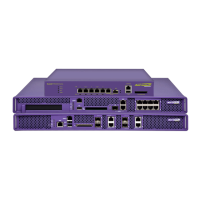Summit WM3000 Series Controller System Reference Guide 363
● Inside - The set of networks subject to translation. These are the internal addresses you are trying
to prevent from being exposed to the outside world.
● Outside - All other addresses (usually valid addresses located on the Internet). Outside addresses
pose no risk if exposed over a publicly accessible network.
5 Define the NAT Direction from the drop-down menu. Options include:
● Source - The inside network is transmitting data over the network its intended destination. On
the way out, the source IP address is changed in the header and replaced by the (public) IP
address.
● Destination - Packets passing through the NAT on the way back to the controller managed LAN
are searched against to the records kept by the NAT engine. There the destination IP address is
changed back to the specific internal private class IP address to reach the LAN over the controller
managed network.
6 Enter the Actual Address used at the local (source) end of the NAT configuration. This address (once
translated) will not be exposed to the outside world when the translation address is used to interact
with the remote destination.
7 Enter the Local Port (1 - 65535) used to for the translation between the controller and its NAT
destination.
8 Use the Protocol drop-down menu to select either TCP or UDP as the protocol
After selecting (and saving) a protocol type of TCP or UDP (using the Web UI), the controller CLI will not display
the selected protocol type or provide an option to configure it. Ensure both the protocol and port are defined
using the Web UI.
9 Enter the Global Address to assign to a host in the outside network. This should be interpreted as a
secure address.
10 Displays the Global Port used to for the translation between the controller and its NAT destination.
11 Refer to the Status field for the current state of the requests made from applet. This field displays
error messages if something is wrong in the transaction between the applet and the controller.
12 Click OK to use the changes to the running configuration and close the dialog.
13 Click Cancel to close the dialog without committing updates to the running configuration.
Configuring NAT Interfaces
The NAT Interface is the VLAN used to route controller data traffic between the source and destination
address locations within the controller-managed network. Any of the default VLANs is available as the
NAT interface, in addition to any other VLANs created. In addition to selecting the VLAN, specify the
Inside or Outside NAT type.
To view and configure a NAT interface:
1 Select Security > NAT from the main menu tree.
2 Click on the Interfaces tab.

